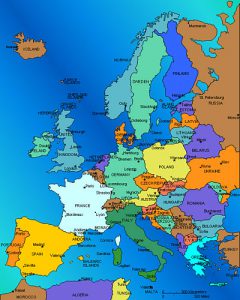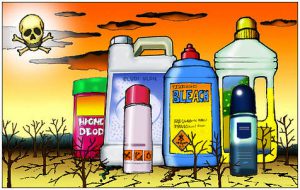Written on 24/11/2010 by DocLogo+
Source: Marianne
In order to produce clothes or shoes, take some tissue or leather, threads and of course..toxic elements of different kind. According to the Arte TV channel report taken up by Hexaconso, Asia has turned into fashion paradise that kills; more and more factories use toxic substances when making clothes. Obviously, you look at your wardrobe from a different point of view.
Last summer Arte broadcast an extremely fascinating report on the process of manufacturing in Asian countries; in such sectors as textile and leather. Interesting, but above all enlightening and frightening!
Toxic products used in agriculture were already pointed fingers at in the past, and now we also find toxic elements in our clothes and accessories.
Everything starts in Europe, where chemical industry makes various toxic products, which are more or less harmful to humans and to the environment; then it exports them to the “low cost” countries. These products will be then used to make jeans, T-shirts, underwear, shoes, toys..that we will then find in our shops and afterwards in our homes.
By the way, these toxic elements used without any precaution in such countries as India or Bangladesh have already poisoned workers and their families. This concerns the greatest fashion brands and they are cited in this report: H&M, C&A, Esprit, Zara (hmm..I’m sure I have seen these brands somewhere..)
Among currently used poisons, we can mention dimethylfumarate (DMFu) that we usually find in small plastic bags in shoe boxes for example. At room temperature, it has the form of white crystals, almost without any odor, and it has antifungal (anti-mold) proprieties, that is to say it destroys and avoids fungus development.
It is used mainly to encourage the preservation of seeds, textiles, leather products, furniture, especially while stocking and transporting these items. Theoretically, the usage of the DMF against fungus and mold is forbidden in Europe according to the 98/8 EC guideline, called “biocides” guideline. However, this product is still used for the manufacturing of most products in Asia, for example shoes, sofas, chairs, leather goods. This merchandise is rarely controlled, especially when they do almost no good because there is no obligation to take them out of the market; the company that imports them is not punished either. In France, there have been about a hundred cases of irritated skin every year, sometimes very severe, due to the skin’s exposure to the DMF.
 For some time, China has not been able to meet the world needs for leather. Therefore, Bangladesh has become one of the most important leather exporters. We can find calfskin leather in abundance there and the workforce is the cheapest one too. What is more, the regulations concerning the environmental protection and the protection of the workers is almost inexistent. Whereas, European tanneries follow the European Community strict rules regarding this and therefore they pay a lot for processing the wastes and for protecting their employees. This is one more reason for European brands to go and get cheap leather in such a country.
For some time, China has not been able to meet the world needs for leather. Therefore, Bangladesh has become one of the most important leather exporters. We can find calfskin leather in abundance there and the workforce is the cheapest one too. What is more, the regulations concerning the environmental protection and the protection of the workers is almost inexistent. Whereas, European tanneries follow the European Community strict rules regarding this and therefore they pay a lot for processing the wastes and for protecting their employees. This is one more reason for European brands to go and get cheap leather in such a country.
 The list of chemical products potentially dangerous to humans and to the environment used for tanning leather is very long. Among them we can count chromium salts, one of which is hexavalent chromium (chromium VI), which is carcinogenic if you inhale it and it is an allergen if there is contact with flesh. We can also cite chlorinated organic substances that attack respiratory roots, ethylene oxide that affects the gene pool, various heavy metals (aluminum, nickel, lead, mercury..), and products based on cyanide… Bengali workers, totally ignorant about the toxicity of these products, work with them without any protection, very often barefoot and bare-handed, without a protection mask. Wastewater, full of toxic products, is poured into the streets without being treated, polluting the towns and agriculture land little by little.
The list of chemical products potentially dangerous to humans and to the environment used for tanning leather is very long. Among them we can count chromium salts, one of which is hexavalent chromium (chromium VI), which is carcinogenic if you inhale it and it is an allergen if there is contact with flesh. We can also cite chlorinated organic substances that attack respiratory roots, ethylene oxide that affects the gene pool, various heavy metals (aluminum, nickel, lead, mercury..), and products based on cyanide… Bengali workers, totally ignorant about the toxicity of these products, work with them without any protection, very often barefoot and bare-handed, without a protection mask. Wastewater, full of toxic products, is poured into the streets without being treated, polluting the towns and agriculture land little by little.
Kept in containers, poisoned leather is then brought to European ports. According to the Hambourg Port Occupational Healthcare, one container out of two coming from Asia is contaminated by chlorinated substances. In order to avoid opening them and inhaling the gas coming out of the container, the contents are controlled by introducing a special probe into the closed container! However, the customs do only random checks, there is no legal regulation to prevent the contaminated containers from circulating around Europe freely. Therefore, it is the employees that will be opening these containers and stocking the products who will be exposed to these toxic gases.
Textile industry
In addition to the leather, textile industry is a sector that uses a lot of chemical products potentially dangerous to humans. Thus, in the central warehouse of the H&M brand, at Hambourg Port, 70% of the employees complain about pains that might be the result of poisoning by the products they are working with.
An employee of Esprit, whose work consisted in ironing the jeans as soon as they were taken out of the containers, suffers today from severe respiratory problems. They are most likely caused by the dichloromethane (one of the galling paint removers) that you can find in jeans manufactured in Asia.
 When fashion kills! It’s because of the faded, worn out and jeans with holes in fashion that hundreds of Turkish workers have died. The technique used to make these jeans “fashionable” is called the sandblasted effect (you project sand particles on the jeans to wear the out). It was of course practiced without any suitable protection for the employees. Today it is forbidden in Turkey but not in Bangladesh where some workers are only protected by a small tissue on the nose. This does not protect their lungs from tiny particles of quartz, that eventually asphyxiate them completely.
When fashion kills! It’s because of the faded, worn out and jeans with holes in fashion that hundreds of Turkish workers have died. The technique used to make these jeans “fashionable” is called the sandblasted effect (you project sand particles on the jeans to wear the out). It was of course practiced without any suitable protection for the employees. Today it is forbidden in Turkey but not in Bangladesh where some workers are only protected by a small tissue on the nose. This does not protect their lungs from tiny particles of quartz, that eventually asphyxiate them completely.
Another activity that involves a lot of toxic elements, is the dyeing. For products made of cotton, this happens in India. Tirupur, located in the South of India, is a new “Eldorado of textile” with around 10 000 factories that produce clothes for European brands nonstop.
The dyeing is the activity that uses a lot of elements harmful to humans and to the environment. Indeed, Azo dye is used, which is forbidden in Europe, as well as chlorinated one together with heavy metals (for brilliance)… The darker the color is, the more important the concentration of toxic elements in it will be (black underwear, so popular for being chic and sexy, is a real concentration of poison…). Indian workers are not aware of how toxic and dangerous the elements they are working with are if they use no protection or no precaution. We are not taking into account the number of explosions and fires in Tirupur factories.
The workers slosh barefoot in the wastewater of dye and bleaching, in which they pour, very often without any masks of gloves, tip-up carts of toxic products. In order to get rid of the wastewater , they evacuate it using shovels and plastic bags and make fields full of dirt. These bags are thrown on the piles of toxic residues that invade Tirupur, whose water and land have been both entirely contaminated in only twenty years or so. Doctors of Tirupur raise the alarm bell. In 10 years, the number of people having cancer has doubled; even some clinics specialized in oncology had to be set up in Tirupur. However, there is no question of the authorities doing research on the possible link between cancer and textile industry..
Tirupur has only textile factories. There are also very beautiful hotels where European customers stay; they come to buy textile at cheap prices. These hotels are so comfortable that they never leave them; it is the managers of Indian companies that come to meet them there in order to prevent them from seeing the conditions of work in the factories as well as from inhaling some toxic odors…
At the hands of this sad truth, some choose organic cotton, on which H&M counts a lot, for instance. In India, however, organic cotton and normal one are next to each other in the field, and we can ask ourselves if there is anything organic left when adjacent land is flooded with pesticides. In textile factories, organic cotton and normal one are simply divided into two piles and there is a small piece of paper to indicate which one is organic. This makes the factory manager interviewed for this report laugh. What is more, the dye for organic cotton is the same as the one used for T-shirts sold at 2 euros! This is not surprising that a few clever people, trying to use this new organic trend, offer organic T-shirts of various colors at very competitive prices. According to the specialists, today there is more organic cotton sold than there is organic cotton actually grown! There is no mistake: the brands offering real organic textile are very rare.
Last tiny detail: do not even expect to read on the labels of your shoes, T-shirts or underwear Made in India, China or Bangladesh which elements have been used for their production, no one has ever dared do that! Chanetelle prefers putting “Designed in France” on its black underwear full of toxic products! It is so much sexier!
